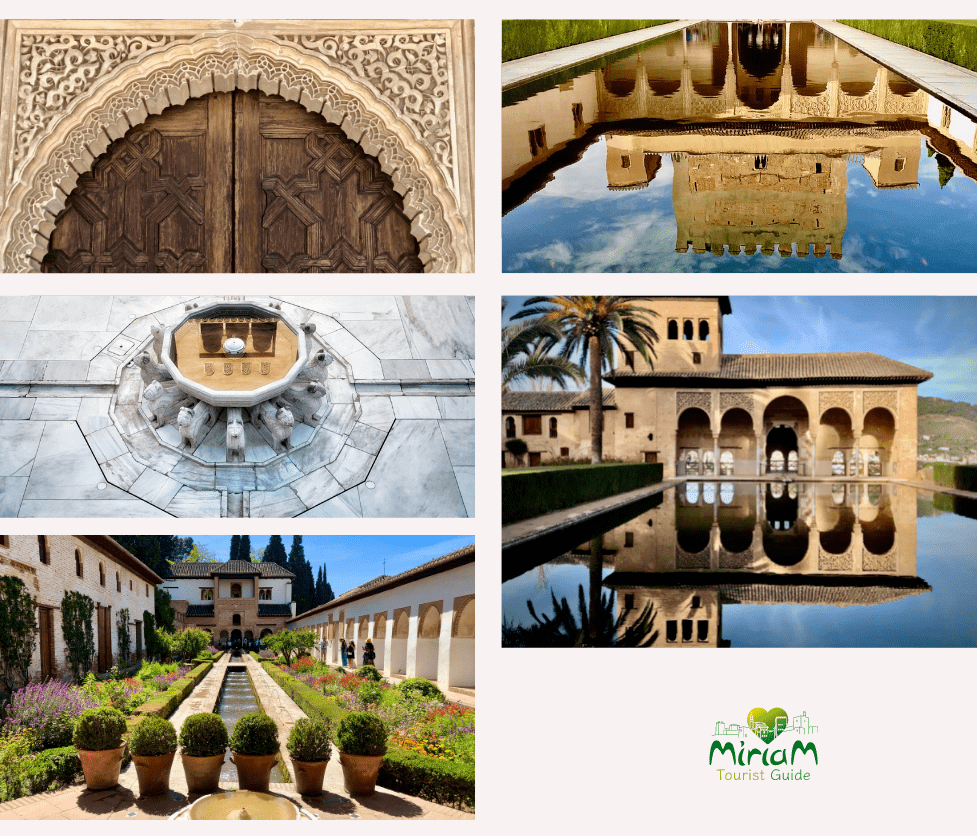
03 Aug 5 hidden Secrets of the Alhambra Palaces
The Alhambra Palaces Secrets
The Alhambra Palaces are world-famous, but what does the word palace evoke?
When we think of a palace, we imagine a monumental building, a large and luxurious mansion destined as a residence for kings, sultans or important people.
However, the Alhambra is different because it is not a palace, it is a palatine city with a military area, a “medina” (city), gardens and of course a residential area (palaces).
If you plan to visit the Alhambra I recommend these two posts where I explain how to buy the Alhambra tickets in 5 easy steps or 4 ways to get to the Alhambra.
Every palace hides a secret
Did you know that the Alhambra has its secrets?
The daily life of this palatine city was mysterious, in the following description of every Alhambra palace you will find a secret, the others you will have to discover on your next visit.
The 5 Alhambra Palaces
At present, five palaces can be visited: Mexuar, Comares, Patio de los Leones, Partal and Palacio del Generalife.
Mexuar Palace
This Alhambra Palace known as Mexuar Palace or Maswar, is one of the three Nasrid Palaces in the Alhambra.
Its original function was as a Surá or Council of Ministers meeting place and the Sultan’s courtroom where the Sultan dispensed justice.
However, with the Christian kings, it was used as a chapel and as a private room for Isabella I of Castile and Isabella I of Portugal.
In the interior of this palace begins an underground Alhambra, with more than 15 kilometers of tunnels and secret passages to safeguard the sultan’s life in the case of a siege and to allow the soldiers to move without being seen.
Comares Palace
Also known as Arrayanes or Comares palace, this Alhambra Palace was called in Arabic “Qasr al-sultan” which is means Sultan’s Fortress’s and “Dar al-Mulk “a royal house.
It combines two uses and is divided into two areas: the courtyard and the throne room.
▶️ The courtyard has a pond; “albirka” in Arabic. The pond water is not just water, it is a mirror. It is an invitation to dream and see the world in reverse.
▶️ The throne room, or ‘arsh‘ in Arabic, means pavilion or throne. The sultan received in this room the important personalities and high-ranking ambassadors.
Today it is the Mediterranean and European area’s most impressive preserved medieval hall.
Furthermore, if you pay attention to the wall decoration you will discover that the Alhambra is an open book that describes itself through its epigraphy.
It tells us the story about the palaces, describes magical corners, praises the sultan, shows respect for Allah, recites suras from the Qur’an, etc. …..
The happy garden of Alhambra Palace: The Court of the Lions
The court of the lions was known in Nasrid times as “al-Riyad al-Said“. It is mean the happy garden.
It was used as a harem, the Sultan’s mother’s dwelling and a celebration venue.
This Alhambra Palace is famous for its fountain in the central courtyard. It is from the XIV century and it composed of twelve unequal white marble lions standing guard.
However, the Lion Palace is impressive for its rectangular courtyard surrounded by a portico with 124 slender white marble columns and its 4 adjoining rooms.
The Alhambra’s columns dance with the earthquakes. They were built to resist the seismic movements of the city.
The columns have a grey lead sheet between the base and the columns which allows for that almost musical movement when the earth shakes in Granada.
The Court of the Lions is undoubtedly the most delicate and beautiful palace in the Alhambra.
The Partal
The Partal was an area where the first alcazars were erected in the Alhambra.
After the Catholic Monarchs took Granada, it was the headquarters of the Alhambra’s Mayor’s Office and the General Captaincy of the Kingdom.
Over the years the area was abandoned, but you can still enjoy the Torre de las Damas, an oratory, several houses and a restored garden.
The original wooden roof of the Ladies’ Tower was taken to Germany by its former owner, Herr Artur Gwinner. It can be seen in the Berlin Museum.
After visiting the Nasrid palaces, I recommend that you take a leisurely stroll through this area.
The Generalife Palace
The Generalife is part of the Alhambra complex.
It began to be used in the 14th century as a royal residence in the countryside outside the walls of the Alhambra.
It had a main palace surrounded by gardens, farmland, animal corrals and hunting grounds for the use of the sultan.
The Generalife was a very productive almunia or farmhouse, where fruit trees, vegetables and aromatic plants were grown in abundance.
The word Generalife comes from two Arabic words: “djennat” and “al-arif“. They meaning is “Garden of the Architect” or “Paradise of the Architect”, referring to Allah as the architect of the world.
According to Washington Irving’s legend, the Generalife was built to protect Ahmed al Kamel “the Perfect”, a young Moorish prince who was under a terrible curse, from the whims of love.
The Generalife is still a paradise. Strolling through it will take you back to the summer nights spent there by the sultan and his family.
Beyond the Alhambra Palaces
Not only the Alhambra Palaces will surprise you, the city itself will also captivate you.
No matter how many times you have heard of, read about or even visited this complex, there is always something new to discover.
If you would like to have a private guide for your visit, do not hesitate to contact please me. I will be happy to reveal more of the Alhambra palace secrets to you.



Sorry, the comment form is closed at this time.